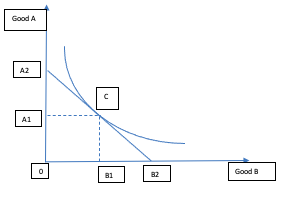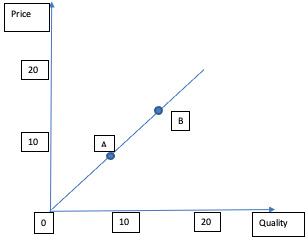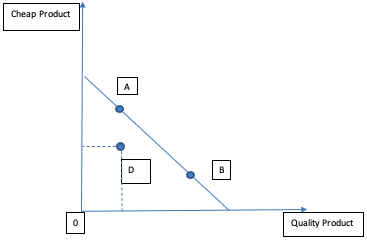Introduction and Background
In today’s fast-paced markets and ubiquitous digitalization, competition in virtually every industry intensifies. Globalization and simplified logistics provide opportunities for any organization to operate in any region, and demand levels can largely depend on a company’s ability to market its products. In the context of this scenario, it is necessary to consider the conditional opposition of two firms engaged in the production and sale of a particular type of small household appliance – robot vacuum cleaners. In order to gain an advantage and increase profits in parallel with the continuous growth of competitiveness, it is proposed to consider the decoy effect and consumers’ dependence on the menu.
The focus is on the firm whose products are of worse quality but have a lower price. Initially, the niche advantage is on the opponent’s side – their more expensive but high-quality, functional robot vacuum cleaners are more popular. Therefore, among the basic steps of striving for leadership with only two firms is suggested to consider strategies to increase the number of sales. When evaluating the potential effect of correcting an organization’s advertising behavior, the pricing process and requirements for market success become clearer. With the decoy or bait-and-switch marketing strategies described, there is an opportunity to increase a firm’s profitability and gain a larger percentage of the market by pushing the competitor to the back burner.
Menu Dependence
The menu dependence effect is part of the general theory of decision-making. According to this theory, the consumer’s decision-making is conditioned by the quantity and quality of the options provided for selection (Maltz and Rachmilevitch, 2021). In this exact context, it may be noted that affordability and logistics are often a higher priority than product quality (Dubé, Joo, and Kim, 2022). Moreover, even obvious problems with durability or a purchase guarantee, if the buyer is aware of them, may not always prevent him from preferring a cheaper product.
Nevertheless, this phenomenon can also work in the other direction if the reputation of the brand manufacturer or distributor is high. In this case, brand connoisseurs may be willing to overpay for a product, sincerely believing in its premium value regardless of its actual capabilities. In the scenario, however, neither firm is a well-known brand, and the major company’s products are clearly not among the premium ones.
When considering the effect of dependence on the menu, one must not forget the related factors of framing and anchoring. The first refers to the design of the options served to the consumer, given the context or wording of the description and the offer (Deepak and Jeyakumar, 2019). In this case, the correct information about the cheaper model is very important, in which the main emphasis is on the cost. In parallel, it is possible to add some bonus to increase the degree of attention to the product – an extra month of warranty or a small discount will seriously influence the client’s choice.
The anchoring effect also refers to menu dependence factors in decision-making. It is the result of attention to and study of the phenomenon in psychology, behavioral economics, and marketing and emphasizes the consumer’s initial impression of the product (Appel et al., 2020). In this case, the initial brand may not matter, and a more expensive product, seen first, may contribute to underestimating the following cheaper offerings and seeking a cheaper option. In the context of the considered scenario, it is practically impossible to influence this effect, except for increasing the level of investments into advertising and striving to capture the client’s attention with the right packaging.
Thus, applying the theory of dependence on the menu is possible when it is competently combined with the decoy effect, which will be discussed later. Without additional options to increase sales, it is only necessary to strengthen the work of the marketing department, to allocate a small price, a nominal discount, or provide other bonuses, such as related services or cheap extras. However, the result of these actions is likely to have little impact on the goal, which is to lure a significant portion of potential customers away from a competitor. Without the implementation of decoy strategies, the market division will not change much and will correspond to the distribution according to the financial capabilities of consumers.
The Decoy Effect
In psychological and cognitive-behavioral theory, cognitive distortion is caused by additional options or decoys. According to Li, Du, and Wei (2020), this effect can influence decision-making even between two basic decisions by adding a third, maximally unattractive one. It is largely based on the idea of consumers making decisions based on the attributes and benefits published by the offering party.
The decoy effect is an effective marketing tool that helps to increase demand for the desired choice. It is possible to use an enhanced contrast effect by adding an even lower quality product at a minimum price to reduce the attractiveness of the most expensive product, which belongs to competitors (Wang, Ryan, and Yang, 2019). However, this method should not be considered in this case because it may negatively affect the company’s reputation and has little correlation with the market of robot vacuum cleaners, which are not a widespread product and do not belong to the essential goods.
Under the terms of the scenario, it makes the most sense to consider the firm adding one new robotic vacuum cleaner model at an inflated price. The cost level of the decoy should not exceed the cost of the competitor’s main product, and the model itself may have only a slight advantage over the original product, the sales of which should be increased. In this case, the new line of models must exist because there will be demand for it, and its advantage may consist only of a complete set or color of the vacuum cleaner. Moreover, the difference in the inflated cost should be significantly higher than the acquired advantage to push the consumer to realize the benefits of the desired option.
Using the proposed strategy likewise draws attention to the phenomenon of dependence on the menu, part of the global theory, which is the essence of adding more choices. The effect that will be formed in the consumer with the knowledge of the two main models in the market will help them to evaluate the new conditions in terms of existing facts:
- A more expensive model of better quality;
- A cheaper model of average quality;
- A new robot vacuum cleaner of acceptable quality, no different from the cheaper model.
Thus, when the third fact appears, the consumer can consider what is happening to be a price increase trend or reconsider their attitude to the functionality of the cheaper option and lean towards the necessary choice. It is worth noting that, to a large extent, this strategy, like most marketing strategies, is aimed at the hesitant or undecided about the choice.
Changing the decision of fans of specific brands or having a precise quantity of finances aimed at a niche expenditure is almost impossible with baiting. It is largely due to the fact that they apply certain cognitive filters when analyzing the market or minimize consideration of options in principle (Wu and Cosguner, 2020). Emphasis must also be placed on the fact that robot vacuum cleaners belong to the premium segment, in which many consumers prefer a more expensive product because they have the financial means and expect high quality.
Therefore, another strategy can be offered to add a decoy to the consumer’s choices. Developing a model with slightly more advanced functionality and setting its price above the premium sector of competitors can make supporters of quality-price dependence doubt. If a cheaper model has similar functionality, some of the fans of expensive products may also be attracted to choose the necessary option, which will increase the firm’s sales and profitability and contribute to its leadership in the segment.
The Graphic Description
In the case of the graphic consideration, it is necessary to consider the situation in a general format and the case of the decoy application. Thus, there is a graph of consumer indifference, which can be considered in a standard format (Fig. 1). However, given the complete substitutability of the product, the curve in this graph can be expressed in a straight line, given the general market demand and the lack of need to purchase a large number of products of the same and a second kind (Lorig, 2020). In this case, firms are labeled A and B, and line A2B2 represents this indicator. In addition, the presented theoretical point C in the coordinates of the number of goods A1B1 is a market balance point with equal levels of customer preference.

To consider the dependence of goods on each other, it is much better to present a graph of the dependence on quality and cost. This format, shown in Fig. 2, defines a directly proportional relationship between quality and price. Point A shows the product of interest, the cheaper and lower quality. Point B, in turn, reflects the direct position of the more expensive brand. The price/quality combination is taken into account based on the characteristics of these two goods.

When adding a decoy, its inconsistency with the indifference curve and the price/quality indicators becomes apparent. For this reason, Fig. 3 shows a shift in consumer interest towards the cheaper option required. The added lure D, with a comparable quality level to A, has a much higher price, which contributes to attracting attention to the cheaper variant.

Consumer Behavior Example
In the context of considering examples of the use of such strategies, it should be noted that they are widespread. Virtually all of today’s companies use lure addition techniques, and in doing so, significantly increase their sales. In this case, even the abundance of competitors often does not affect the introduction of additional unprofitable options because all leading manufacturers and service providers use similar methods.
The most obvious example is food and other similar trades. For example, a small bottle of Coke or Pepsi is much more expensive in terms of liters than larger bottles. At the same time, added medium often acts as an additional option and a type of decoy. The average drink bottle is not profitable for the buyer regarding price or volume. Therefore, against this background, the large variant is considered the most profitable and attractive if the original purpose of the purchase was not to buy a small bottle. Similar schemes can be seen in many packaged goods in retail, and the most disadvantageous options are often decoy for consumers.
Another example is the original pricing of newspaper or magazine subscriptions. At the time of the full-fledged digital magazine Time, there was a split subscription option, as in many publications of today (Time Magazine, 2023). Despite a change in their current strategy to enhance the effect through discounts and promotions, the original subscription options included just the decoy.
The cheapest option was exclusively digital, and paper and paper-digital were provided at the same or similar price. In this case, the paper version acted as the decoy, as the most unprofitable and pointless to purchase, even if the digital version was not available. The consumer’s choice almost always stops at the variant with the greatest advantages given the same cost (Lorig, 2020). Thus, it is possible to list many more examples of marketing physical and digital goods and services in which the decoy method is actively used.
Conclusion
Thus, the effectiveness of using the decoy method in the context of the menu dependence effect to increase the sales of the required robot vacuum cleaner model becomes evident. Moreover, with the correct implementation of this strategy, it is possible to increase not only the firm’s profitability but also the market share with subsequent dominance. Due to the peculiarities of consumer psychology, the methods of taking into account all the factors of the theory of choice determination are very important for the final formation of conditions ideal for the development of the company’s activities.
Reference List
Appel, G. et al. (2020) “The future of social media in marketing,” Journal of the Academy of Marketing Science, 48(1), pp. 79–95. Web.
Deepak, R. K. A. and Jeyakumar, S. (2019) Marketing Management. Educreation Publishing.
Dubé, J.-P., Joo, J. and Kim, K. (2022) Discrete-choice models and representative consumer theory. Cambridge, MA: National Bureau of Economic Research.
Li, F., Du, T. C. and Wei, Y. (2020) “Enhancing supply chain decisions with consumers’ behavioral factors: An illustration of decoy effect,” Transportation Research Part E: Logistics and Transportation Review, 144. Web.
Lorig, M. (2020) “Bond indifference prices and indifference yield curves.” Web.
Maltz, A. and Rachmilevitch, S. (2021) “A model of menu-dependent evaluations and comparison-aversion,” Journal of behavioral and experimental economics, 91. Web.
Time Magazine (2023) Subscription UK. Web.
Wang, Y.-C., Ryan, B. and Yang, C.-E. (2019) “Employee brand love and love behaviors: Perspectives of social exchange and rational choice,” International journal of hospitality management, 77, pp. 458–467. Web.
Wu, C. and Cosguner, K. (2020) “Profiting from the decoy effect: A case study of an online Diamond retailer,” Marketing science, 39(5), pp. 974–995. Web.